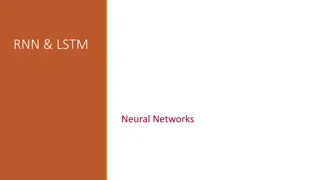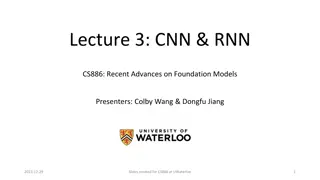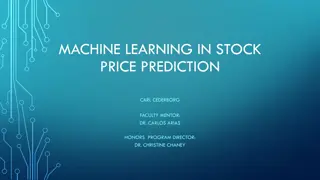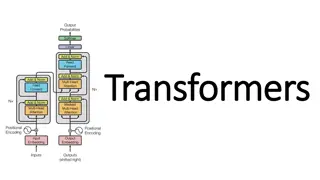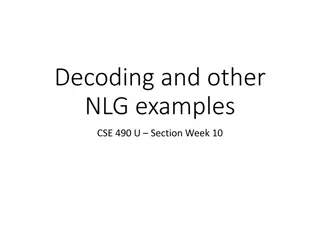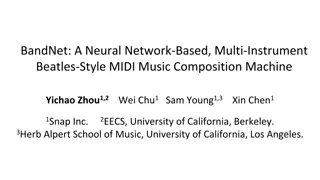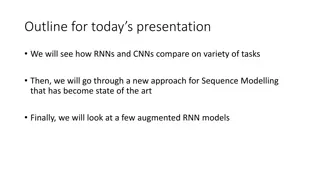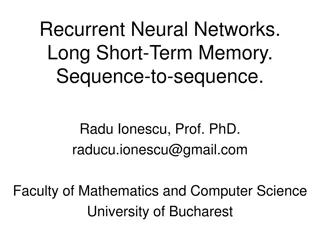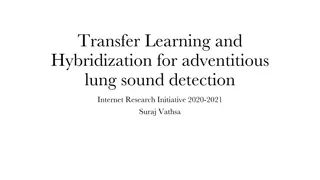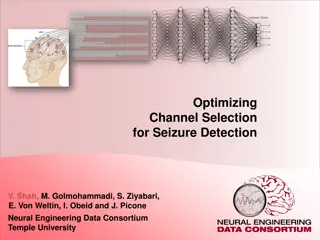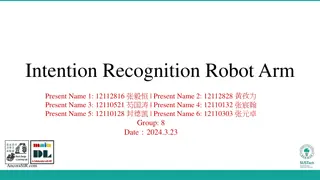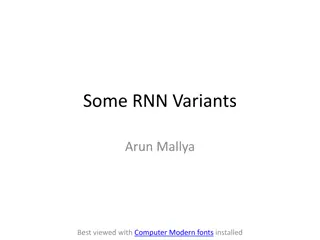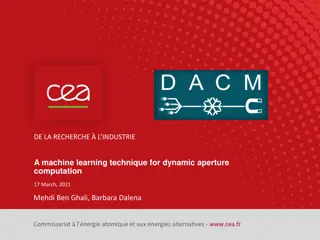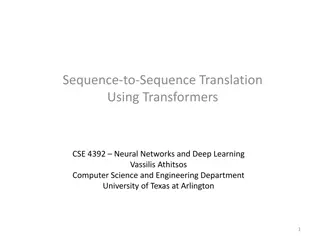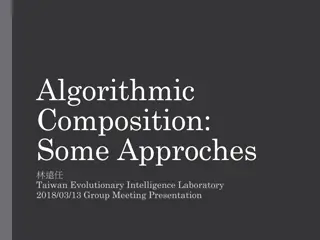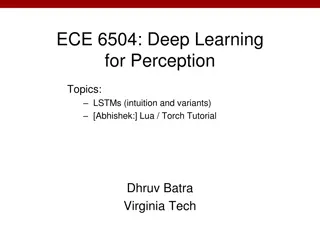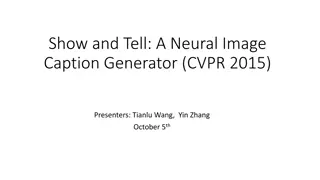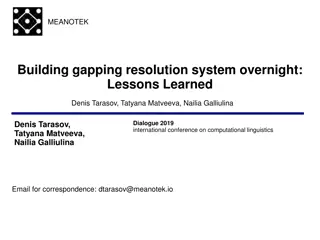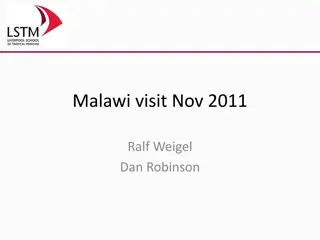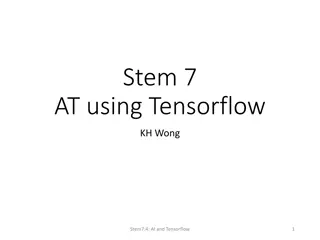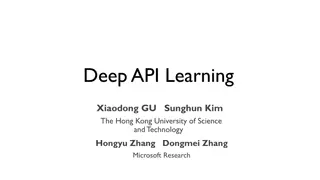Recurrent Neural Networks (RNN) and Long Short-Term Memory (LSTM)
Recurrent Neural Networks (RNNs) and Long Short-Term Memory (LSTM) are powerful tools for sequential data learning, mimicking the persistent nature of human thoughts. These neural networks can be applied to various real-life applications such as time-series data prediction, text sequence processing,
16 views • 34 slides
Recent Advances in RNN and CNN Models: CS886 Lecture Highlights
Explore the fundamentals of recurrent neural networks (RNNs) and convolutional neural networks (CNNs) in the context of downstream applications. Delve into LSTM, GRU, and RNN variants, alongside CNN architectures like ConvNext, ResNet, and more. Understand the mathematical formulations of RNNs and c
2 views • 76 slides
Machine Learning for Stock Price Prediction
Explore the world of machine learning in stock price prediction, covering algorithms, neural networks, LSTM techniques, decision trees, ensemble learning, gradient boosting, and insightful results. Discover how machine learning minimizes cost functions and supports various learning paradigms for cla
2 views • 8 slides
Evolution of Neural Models: From RNN/LSTM to Transformers
Neural models have evolved from RNN/LSTM, designed for language processing tasks, to Transformers with enhanced context modeling. Transformers introduce features like attention, encoder-decoder architecture (e.g., BERT/GPT), and fine-tuning techniques for training. Pretrained models like BERT and GP
1 views • 11 slides
Decoding and NLG Examples in CSE 490U Section Week 10
This content delves into the concept of decoding in natural language generation (NLG) using RNN Encoder-Decoder models. It discusses decoding approaches such as greedy decoding, sampling from probability distributions, and beam search in RNNs. It also explores applications of decoding and machine tr
0 views • 28 slides
BandNet: Neural Network-Based Multi-Instrument Music Composition
This research project introduces BandNet, a neural network-based system for multi-instrument Beatles-style MIDI music composition. By encoding musical scores using LSTM-RNN, the system addresses limitations of existing works and supports generating music scores for various purposes. Users can engage
0 views • 8 slides
Real-Time Network Traffic Prediction Using LSTM Neural Network
Explore Long Short-Term Memory (LSTM) models for real-time network traffic flow prediction. Learn about LSTM architecture, many-to-one vs. many-to-many models, and practical applications with market data. Gain insights into the unique formulation of LSTM networks for effective training and generaliz
0 views • 13 slides
RNNs and CNNs for Sequence Modelling: A Dive into Recent Trends and TCN Models
Today's presentation will delve into the comparison between RNNs and CNNs for various tasks, discuss a state-of-the-art approach for Sequence Modelling, and explore augmented RNN models. The discussion will include empirical evaluations, baseline model choices for tasks like text classification and
0 views • 20 slides
Recurrent Neural Networks: Fundamentals and Applications
Explore the realm of Recurrent Neural Networks (RNNs), including Long Short-Term Memory (LSTM) models and sequence-to-sequence architectures. Delve into backpropagation through time, vanishing/exploding gradients, and the importance of modeling sequences for various applications. Discover why RNNs o
0 views • 102 slides
Advanced Artificial Intelligence for Adventitious Lung Sound Detection
This research initiative by Suraj Vathsa focuses on using transfer learning and hybridization techniques to detect adventitious lung sounds such as wheezes and crackles from patient lung sound recordings. By developing an AI system that combines deep learning models and generative modeling for data
0 views • 6 slides
Optimizing Channel Selection for Seizure Detection with Deep Learning Algorithm
Investigating the impact of different channel configurations in detecting artifacts in scalp EEG records for seizure detection. A deep learning algorithm, CNN/LSTM, was employed on various channel setups to minimize loss of spatial information. Results show sensitivities between 33%-37% with false a
0 views • 12 slides
Assistive System Design for Disabilities with Multi-Recognition Integration
Our project aims to create an assistive system for individuals with disabilities by combining IMU action recognition, speech recognition, and image recognition to understand intentions and perform corresponding actions. We use deep learning for intent recognition, gesture identification, and object
0 views • 14 slides
Recurrent Neural Networks (RNNs) and LSTM Variants
Explore the basics of Recurrent Neural Networks (RNNs) including the Vanilla RNN unit, LSTM unit, forward and backward passes, LSTM variants like Peephole LSTM and GRU. Dive into detailed illustrations and considerations for tasks like translation from English to French. Discover the inner workings
0 views • 36 slides
Machine Learning Technique for Dynamic Aperture Computation in Circular Accelerators
This research presents a machine learning approach for computing the dynamic aperture of circular accelerators, crucial for ensuring stable particle motion. The study explores the use of Echo-state Networks, specifically Linear Readout and LSTM variations, to predict particle behavior in accelerator
0 views • 17 slides
Transformer Neural Networks for Sequence-to-Sequence Translation
In the domain of neural networks, the Transformer architecture has revolutionized sequence-to-sequence translation tasks. This involves attention mechanisms, multi-head attention, transformer encoder layers, and positional embeddings to enhance the translation process. Additionally, Encoder-Decoder
0 views • 24 slides
Algorithmic Composition Techniques in Music Generation
Algorithmic composition involves the use of algorithms to create music, mimicking human composers by generating music based on specific rules and structures. This presentation delves into various approaches such as DeepBach, MuseGAN, and EMI, highlighting the use of evolutionary algorithms, machine
8 views • 35 slides
LSTMs for Deep Learning: A Visual Overview
Delve into the intricate workings of Long Short-Term Memory (LSTM) networks with a series of visual aids and explanations by Dhruv Batra. Explore the intuition behind LSTMs, including memory cells, forget gates, input gates, memory updates, and output gates, shedding light on how these mechanisms en
0 views • 17 slides
Neural Image Caption Generation: Show and Tell with NIC Model Architecture
This presentation delves into the intricacies of Neural Image Captioning, focusing on a model known as Neural Image Caption (NIC). The NIC's primary goal is to automatically generate descriptive English sentences for images. Leveraging the Encoder-Decoder structure, the NIC uses a deep CNN as the en
0 views • 13 slides
MEANOTEK Building Gapping Resolution System Overnight
Explore the journey of Denis Tarasov, Tatyana Matveeva, and Nailia Galliulina in developing a system for gapping resolution in computational linguistics. The goal is to test a rapid NLP model prototyping system for a novel task, driven by the motivation to efficiently build NLP models for various pr
0 views • 16 slides
Educational Exploration Trip to Malawi: Nov 2011 Report
The trip to Malawi in November 2011 aimed to establish educational links with institutions like the LightHouse trust, identify training needs, explore e-learning opportunities, and discuss collaboration possibilities. The project team, including members from LightHouse and LSTM, presented to key par
0 views • 11 slides
Tensorflow Installation and Applications
This content covers the installation process of TensorFlow along with tutorials, usage of Jupyter notebook, and various tests like music genre classification using CNN, Optical Character Recognition with Tesseract, and object recognition with Yolo. It also provides insights into using LSTM for music
0 views • 11 slides
Effective Approaches to Attention-based Neural Machine Translation
This research explores innovative attention mechanisms in Neural Machine Translation, proposing a new model and achieving state-of-the-art results in English-German translation. The study focuses on improving existing attention models to enhance translation accuracy and efficiency, showcasing advanc
0 views • 15 slides
Deep API Learning
Delve into the complexities of deep API learning and programming challenges, exploring topics like parsing XML files, obtaining API usage sequences, and limitations of IR-based approaches. Uncover the nuances of converting strings to integers, understanding semantics, and the significance of RNN arc
0 views • 25 slides
